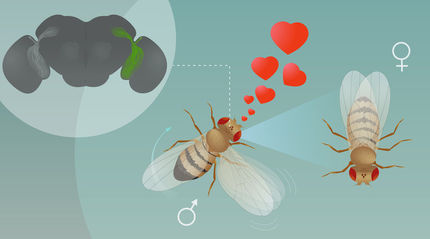Novel sensors enable precise measurement of dopamine
Carbon nanotubes glow brighter in the presence of neurotransmitters. This facilitates the easy and accurate measurement of signals between nerve cells
dopamine is an important signalling molecule for nerve cells. Its concentration could not be precisely determined with both high spatial or temporal resolution until now. A new method has now made this possible: A research team from Bochum, Göttingen and Duisburg used modified carbon nanotubes that glow brighter in the presence of the messenger substance dopamine. These sensors visualise the release of dopamine from nerve cells with unprecedented resolution. The researchers headed by Professor Sebastian Kruss from the Physical Chemistry Department at Ruhr-Universität Bochum (RUB) and Dr. James Daniel as well as Professor Nils Brose from the Max Planck Institute for Multidisciplinary Sciences in Göttingen report on this in the journal PNAS from 25 May 2022.

Sebastian Kruss (right) and Björn Hill are part of the team that was able to directly measure the neurotransmitter dopamine.
© RUB, Kramer
Fluorescence changes in the presence of dopamine
The neurotransmitter dopamine controls the brain’s reward centre, among other things. If this signal transmission no longer functions, it can lead to disorders such as Parkinson’s disease. Moreover, the chemical signals are altered by drugs such as cocaine and play a role in substance abuse disorders. “However, until now there was no method that could simultaneously visualise the dopamine signals with high spatial and temporal resolution,” explains Sebastian Kruss, head of the Functional Interfaces and Biosystems Group at RUB and a member of the Ruhr Explores Solvation Cluster of Excellence (RESOLV) and the International Graduate School of Neuroscience (IGSN).
This is where the novel sensors come into play. They are based on ultra-thin carbon tubes, about 10,000 times thinner than a human hair. When irradiated with visible light, they glow in the near-infrared range with wavelengths of 1,000 nanometres and more. “This range of light is not visible to the human eye, but it can penetrate deeper into tissue and thus provide better and sharper images than visible light,” says Kruss. In addition, there are far fewer background signals in this range that can distort the result.
“We have systematically modified this property by binding various short nucleic acid sequences to the carbon nanotubes in such a way that they change their fluorescence when they come into contact with defined molecules,” explains Sebastian Kruss. This is how his research group has succeeded in turning carbon nanotubes into tiny nanosensors that specifically bind to dopamine and fluoresce more or less strongly depending on the dopamine concentration. “We immediately realised that such sensors would be interesting for neurobiology,” says Kruss.
Coating healthy nerve cells with a sensor layer
In order to do this, the sensors have to be moved into the vicinity of functioning neuronal networks. Dr. Sofia Elizarova and James Daniel from the Max Planck Institute for Multidisciplinary Sciences in Göttingen developed cell culture conditions for this, in which the nerve cells remain healthy and can be coated with an extremely thin layer of sensors. This allowed the researchers to visualise individual dopamine release events along neuronal structures for the first time and gain insights into the mechanisms of dopamine release.
Kruss, Elizarova and Daniel are confident that the new sensors have enormous potential: “They provide new insights into the plasticity and regulation of dopamine signals,” says Sofia Eizarova. “In the long term, they could also facilitate progress in the treatment of diseases such as Parkinson’s.” In addition, further sensors are currently being developed with which other signalling molecules can be made visible for example to identify pathogens.
Original publication
Most read news
Original publication
Sofia Elizarova, Abed Chouaib, Ali Shaib, Björn Hill, Florian Mann, Nils Brose, Sebastian Kruss, James A. Daniel: A fluorescent nanosensor paint reveals the heterogeneity of dopamine release from neurons at individual release sites, in: PNAS, 2022
Topics
Organizations
Other news from the department science

Get the analytics and lab tech industry in your inbox
By submitting this form you agree that LUMITOS AG will send you the newsletter(s) selected above by email. Your data will not be passed on to third parties. Your data will be stored and processed in accordance with our data protection regulations. LUMITOS may contact you by email for the purpose of advertising or market and opinion surveys. You can revoke your consent at any time without giving reasons to LUMITOS AG, Ernst-Augustin-Str. 2, 12489 Berlin, Germany or by e-mail at revoke@lumitos.com with effect for the future. In addition, each email contains a link to unsubscribe from the corresponding newsletter.





















































